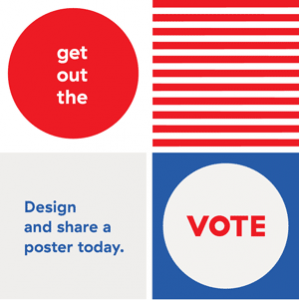Call for Participation
The Upstate New York chapter of AIGA, the professional association for design, is excited to participate in AIGA’s national Get Out the Vote campaign, which is part of a greater design for democracy initiative. The main objective of the campaign is the creation and distribution of non-partisan posters urging individuals to exercise their right to vote in elections. In October, our chapter will showcase the work of our members at a special exhibition in collaboration with the Women’s Rights National Historic Park in celebration of Upstate New York’s role in the history of suffrage. An interdisciplinary panel discussion on voting rights will accompany the opening of the exhibition at the Women’s Rights National Historic Park on October 24 at 5:30pm. All residents of Upstate New York are encouraged to download, print and display posters created by Upstate New York designers. By hanging posters in storefronts, businesses, and resident windows we can create a massive exhibition that spans the state. With your help, we can increase voter turnout while highlighting the work of our local designers.
print and display posters created by Upstate New York designers. By hanging posters in storefronts, businesses, and resident windows we can create a massive exhibition that spans the state. With your help, we can increase voter turnout while highlighting the work of our local designers.
All members of the Upstate New York chapter of AIGA are invited to create posters as part of the national AIGA Get Out the Vote campaign. To get started, download the poster template (zip) from the AIGA website. Although not required, we encourage Upstate New York designers to embed a little Upstate NY flavor and history into their posters. Once designed, submit the poster to the national Virtual Exhibition. Posters submitted prior to October 1, 2016 will be included in both exhibitions planned in Upstate New York.
A Taste of Upstate New York Voting History
Next year (2017) marks the 100th anniversary of women’s suffrage in New York State. Towns throughout Upstate New York, particularly those along the Erie Canal, are important historic sites related to abolition and voting rights. For example, the Wesleyan Chapel in Seneca Falls was the site of the first National Women’s Rights Convention (1848) co-organized by Elizabeth Cady Stanton and Lucretia Mott and resulted in the Declaration of Sentiments. Voting rights was a controversial component of the declaration and resulted in much discussion amongst the 300 attendees (both men and women). Voting rights was ultimately included in the document, perhaps thanks to Frederick Douglass who made an important case for suffrage. Shortly after the convention, Douglass wrote a piece in the North Star that included, “Our doctrine is, that ‘Right is of no sex’.” Douglass, Stanton, Mott and Susan B. Anthony were all later involved in the founding of the American Equal Rights Association that was rooted in universal suffrage.
The stories of suffrage in Upstate New York are numerous. Susan B. Anthony, along with 15 other women, demanded to be registered to vote and attempted to cast votes in the 1872 presidential election. Anthony successfully voted but was arrested two weeks afterwards for voting illegally. Anthony was put on trial and fined $100 (which she never paid) but was never jailed. Anthony went on to become the president of the National American Woman Suffrage Association from 1892-1900. Anthony, like many others who attended the convention in Seneca Falls, died before she could legally vote.
Harriet Tubman, perhaps best known for her work with the Underground Railroad, was also an important advocate for universal equality, including voting rights. At a meeting of the suffrage club in Geneva, NY (1911) Tubman was asked by a suffragette, “Do you believe that women should vote?” Tubman responded, “I suffered enough to believe it.”
Mary Walker, a physician who received the Medal of Honor for her work during the Civil War, was born in Oswego, NY in 1832. Although an important lecturer on women’s suffrage, she did not support an amendment to bestow that right because she believed the right was already embedded in the constitution.
A native of Cicero, NY, Matilda Joslyn Gage, was an author of many important pamphlets and volumes on women’s suffrage, including a co-author (with Stanton and Anthony) of the History of Woman Suffrage.
The fight for suffrage involved much struggle and sacrifice. There are the handful of men and women who are given most of the credit, but there were many involved and many who were arrested and sentenced for what we might label as benign acts today, like picketing. For example, Amy Juengling (Buffalo, NY), Hattie Kruger (Buffalo, NY) and Mrs. Frederick W. Kendall (Hamburg, NY) were all arrested and sentenced to 30 days in the Occuquan workhouse after picketing (1917).
“The true republic—men, their rights, and nothing more; women, their rights, and nothing less” was the bold statement on the cover of the first edition of The Republic, Stanton and Anthony’s weekly women’s rights journal and captures the tireless work and the history made in our backyards.
We encourage chapter members to share Upstate New York’s role in voting rights history in the posters they create during this year’s Get Out the Vote initiative.